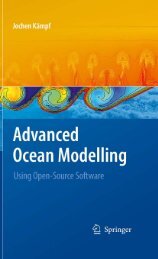Contents
Contents
Contents
- No tags were found...
You also want an ePaper? Increase the reach of your titles
YUMPU automatically turns print PDFs into web optimized ePapers that Google loves.
162 6 Rotational Effects6.15.5 Additional Exercise for the ReaderRepeat this exercise for an ocean uniform in density (ρ 1 = ρ 2 = 1028 kg m −3 )toexplore whether the barotropic instability process alone can produce a similar formof frontal instability. The two-layer version of the shallow-water equations can beadopted for this task, but the reader should avoid division by zero. . .6.16 Density-Driven Flows6.16.1 BackgroundDensity-driven f ows are bodies of dense water that cascade downward on the continentalslope to a depth where they meet ambient water of the same density. Atthis equilibrium density level, these f ows tend to fl w along topographic contoursof the continental slope. Detachment from the seafloo and injection into the ambientocean is also possible. Numerical modelling of gravity plumes started with the“streamtube model” of Smith (1975). This model considers a laterally integratedstreamtube with a variable cross-sectional area and, under the assumption of stationarity,it produces the path and laterally averaged properties (density contrast,velocity) of the plume on a given slope.With an advanced method describing the dynamics of such reduced-gravityplumes, Jungclaus and Backhaus (1994) employed the shallow-water equations fora two-layer flui with an upper layer at rest. Without exchange of flui across the“skin” of the plume, the dynamic governing this model can be written as:∂u 2∂t∂v 2∂t∂u 2+ u 2∂x + v ∂u 22∂y − f v 2 =−g ′ ∂η 2∂x − τ xboth 2 ρ 2∂v 2+ u 2∂x + v ∂v 22∂y + fu 2 =−g ′ ∂η 2∂y − τ ybot(6.72)h 2 ρ 2∂η 2+ ∂(u 2h 2 )+ ∂(v 2h 2 )= 0∂t ∂x ∂ywhere g ′ = (ρ 2 − ρ 1 )/ρ 2 g is reduced gravity, and (τxbot ,τybot ) represents the frictionalstress at the seafloo . These equations are known as the reduced-gravity plumemodel. Interface displacements η 2 are define with respect to a certain referencelevel. When formulated in finit differences, the CFL stability criterion in such amodel is given by:Δt ≤min(Δx, Δy)√ 2g′ h maxwhere h max is maximum plume thickness.
















